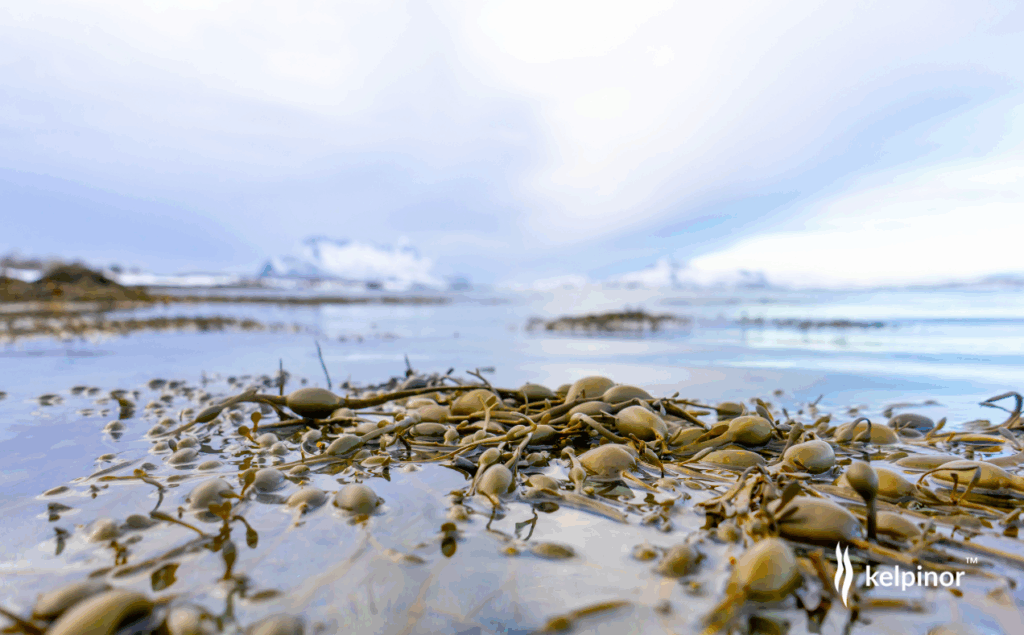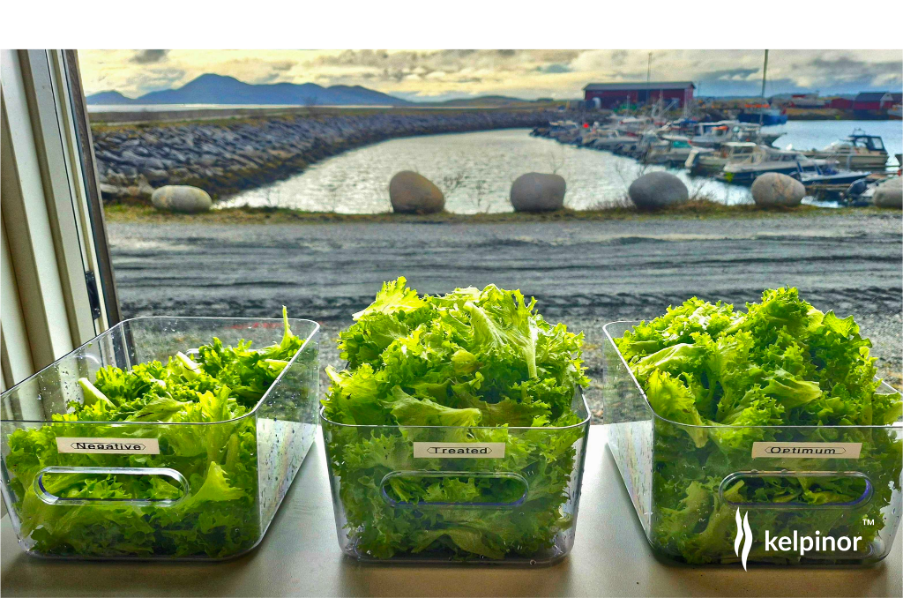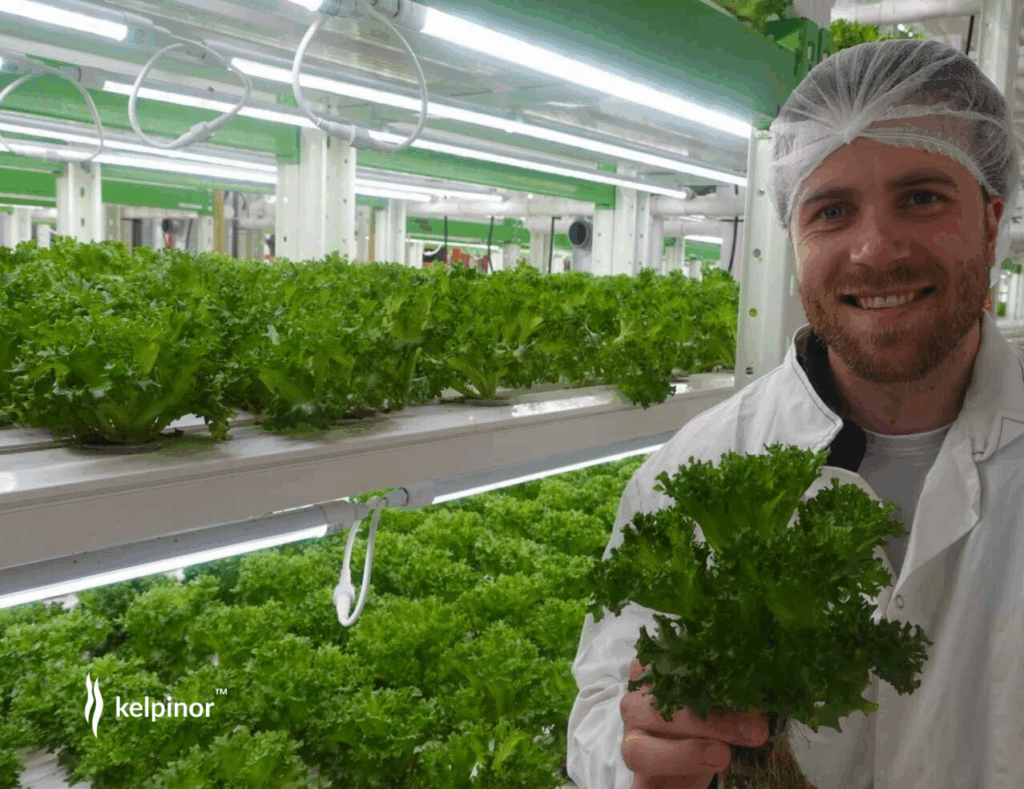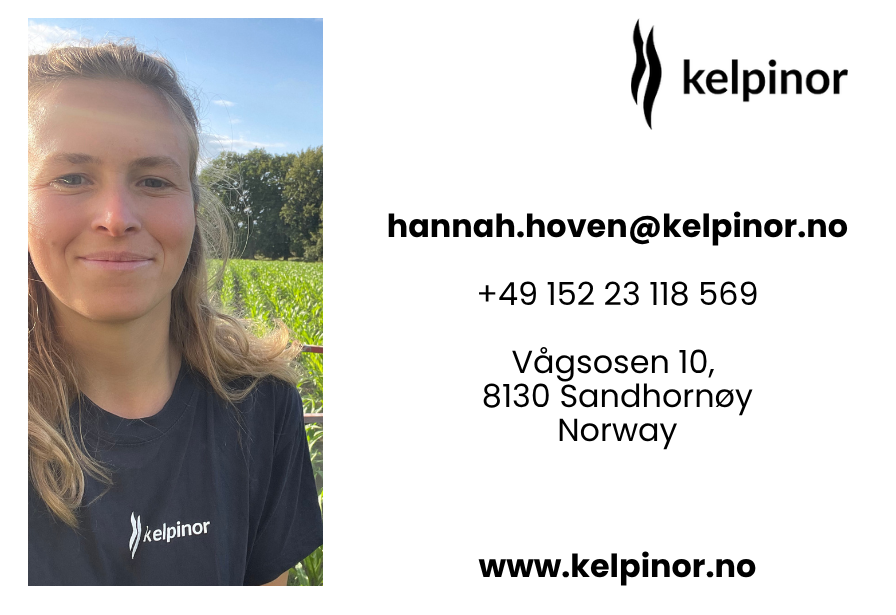AVF recently caught up with Hannah Marie Hoven, Market Developer at Kelpinor, to learn how their algae-based biostimulant is contributing to the agricultural biotech revolution – a solution rooted in regeneration and designed for the future of vertical farming.
“Enabling The Regenerative Future”
Who is Kelpinor?
We are a Norwegian climate action start-up turning cultivated and wild-harvested seaweed into biostimulants for sustainable Controlled Environment Agriculture (CEA), helping growers improve crop performance while reducing operational costs per unit produced. Based on the Arctic coast of Norway, we enjoy views of the mountains and the ocean from our office, a daily reminder of the powerful environment that defines our raw material.
Kelp thrives in these harsh ocean conditions, having evolved unique properties and adaptations that allow it to flourish. By harnessing these properties and transforming seaweed into liquid biostimulants, we support regenerative CEA.
At the core of our mission is the belief that seaweed will play a crucial role in future-proofing our food systems and contributing to global food security. We’re seeing this potential come to life in results from our in-house trials, as well as from independent research institutes and large-scale practical applications — but we’ll get into that later in the article.

What is your technology, and who is it for?
We have developed a seaweed-based biostimulant that comes in the form of a liquid suspension, which is easy to apply and fits seamlessly into existing growing systems. Our product captures the unique bioactive compounds found in kelp and makes them available to plants in controlled environments.
Our biostimulant helps plants do more than just grow, it helps them thrive. By enhancing natural processes, it promotes stronger growth and increases resilience to abiotic stress such as heat or suboptimal lighting. That means crops can perform closer to their optimal potential, even when the growing conditions aren’t perfect.
This is particularly valuable while setting up a farm and in scaling CEA, where conditions like lighting, temperature, or humidity may fluctuate. In such systems, our biostimulant gives plants the extra support they need to stay healthy and resilient, giving growers a more reliable path to high-quality yields.
How do we know it works? To ensure our biostimulant delivers real impact and to ground our work in research, we’ve conducted a range of trials in our in-house lab, where we actively test plants under different temperature, light, and water conditions. By introducing abiotic stress, we can clearly see whether plants treated with our biostimulant continue to grow better and stay healthier compared to untreated controls. The results have been consistently promising, with clear, visible effects even at the phenotypic level: healthier plants and improved growth.
These findings have also been independently validated. A research group at TU Braunschweig, for example, observed that plants treated with Kelpinor’s biostimulant looked significantly healthier than untreated controls in their trials.
Beyond controlled experiments, our technology is already proving itself at scale. At Grønt fra Nord, a vertical farm in Northern Norway, our biostimulant has been applied to over 7,000 heads of lettuce, with excellent results. The crops show strong growth, vibrant appearance, and overall improved quality, reinforcing the effectiveness of our solution in real-world production.

Kelpinor Suspension Ascophyllum is our baseline biostimulant, a premium organic suspension derived from Ascophyllum nodosum (rockweed), sustainably hand-harvested along the northern Norwegian coast. This species is already well-researched and widely used in biostimulant products globally. Starting with Ascophyllum nodosum allowed us to establish a solid foundation with a proven raw material, while staying rooted in local, responsibly managed marine resources.
Still, our long-term ambition is to move away from wild-harvested inputs. Even though our harvesting practices are sustainable and backed by ecosystem monitoring, we are actively transitioning to using cultivated kelp species to ensure full traceability, scalability, and alignment with regenerative ocean farming practices.
We’re currently focusing on developing biostimulants based on two cultivated species available in Norway:
- Alaria esculenta (winged kelp)
- Saccharina latissima (sugar kelp)
These species are not only well-suited for cultivation but also show exciting potential in our lab trials. In the near future, they will play a central role in our product portfolio.
What is unique about your product and approach
At Kelpinor, we bring together centuries-old coastal tradition with modern bioengineering to unlock nature’s resilience for the benefit of vertical growers. Our uniqueness lies in what we preserve – not just what we extract.
Our CEO, Hermann Schips, comes from a long lineage of Norwegian farmers and kelp gatherers who instinctively knew kelp enhanced plant vitality. But tradition alone isn’t enough. Over the last several years, we’ve collaborated with pilot clients and research institutions to identify what truly makes kelp effective in modern cultivation – particularly in high-tech, resource-sensitive environments like vertical farms.
What we’ve discovered is this: the synergy between phytohormones and polysaccharides – naturally occurring in our kelp – plays a significant role in helping crop fertilisations not only grow faster but grow stronger. This means higher yields with lower energy requirements, especially when integrated with existing fertilisation regimes.
But here’s where our approach diverges from the conventional: we don’t isolate and strip away nature’s complexity. Instead, we maintain the full spectrum of bioactive compounds, keeping them intact and active through a proprietary low-temperature process that never exceeds 40°C. That means our product is as close to nature’s original blueprint as possible – preserving the full “biological intelligence” of the seaweed.
The result is a clean, highly potent kelp-based biostimulant produced through a fusion of German bioengineering precision and Norwegian ecological heritage. It’s made to be so pure that it meets standards for human consumption (though we don’t recommend drinking it).
This philosophy – respecting the intelligence of nature while enhancing it for modern agricultural challenges – sets Kelpinor apart. And it’s why vertical growers working with us report not just improved results, but a renewed confidence in their path toward optimisation.
We work with vertical farms in a unique way. We don’t just sell a biostimulant, we deliver a tailored solution. From the very beginning, we work closely with vertical farms to understand their specific goals and challenges, whether it’s inconsistent growth, stress-related crop losses, or yield optimisation. Based on this, we co-develop a customised concept for how our biostimulant can make a measurable difference, a concept that continues to evolve as we learn more about the farm’s system, its needs, and Kelpinor’s biostimulant’s performance in practice.
Our approach goes far beyond handing over a product with generic instructions. It’s about understanding each growing system and designing practical, data-informed interventions that fit seamlessly into existing operations. To back this commitment, we work with a no cure – no pay mindset: if it doesn’t work for you and your crops, you don’t pay.

Take our collaboration with Grønt fra Nord as an example. We visited the farm, worked alongside their team, and supported the implementation directly. That hands-on support allowed their staff to focus on other priorities while we helped manage the crop care side — leading to stronger results and smoother operations.
While not every vertical farm will need continued on-site support, the principle remains the same: we start with a visit and, by asking the right questions, then help find the right solutions. Every farm is different — and so is our approach.
What is the potential of your technology going forward?
Looking ahead, the potential for growers lies in creating more resilient, cost-efficient production systems. With our biostimulant, crops can maintain strong performance even when conditions like lighting or temperature aren’t ideal, reducing the need for intensive climate control. This means lower energy use and, ultimately, lower energy costs. Early results already show that applying the biostimulant costs significantly less than the energy savings it enables. We’re currently quantifying these effects, and our Head of R&D, Lydia Schmidt, will present the latest findings at the AVF Summit in Munich this September.
Don’t miss it — and if you’re eager to learn more, get in touch with us.
But the potential goes far beyond individual farm performance. At Kelpinor, we’re committed to building a regenerative system from sea to soil. Starting with the cultivation of kelp and ending with healthier crops. We’re creating a regenerative supply chain that’s not only sustainable, but scalable.
Through this, we’re contributing to a circular, ocean-based bioeconomy and playing our part in making the global food system more resilient, secure, and future-ready.
What are your goals in the future?
Our goal is to make seaweed-based biostimulants a natural part of every grower’s toolkit, not just a niche innovation, but a standard in sustainable indoor agriculture. We want to lead the transition from wild-harvested to cultivated kelp species, setting a new industry benchmark for quality, scalability, and ecological responsibility.
Norway is uniquely positioned for this. Its long coastline and deep fjords offer ideal conditions for kelp farming. Historically, kelp forests were far more abundant here, and we see the potential to restore that presence through responsible cultivation. The species we grow are native to Norway and are thriving in the cold, nutrient-rich waters along the Arctic coast.
For us, this isn’t just about producing a raw material; it’s about creating a regenerative, scalable supply chain from ocean to farm. One that provides growers with reliable, natural inputs while respecting the limits of marine ecosystems.
As we grow, our focus remains clear: to be a trusted partner for CEA producers, helping them cultivate healthier crops with fewer inputs and lower costs — all while contributing to a circular, ocean-based bioeconomy.
What are you looking for in the VF space -> which kind of collaborators?
We’re actively looking to collaborate with vertical farmers who are working to improve crop resilience, optimise growing conditions, or set up new systems. Whether you’re refining an existing setup or designing something from scratch, we want to understand your goals and challenges and explore how our biostimulants can help support healthier, more consistent crop performance.
From our lab results and large-scale trials, we see real potential and we believe that working closely with growers will help us unlock even more value where it matters most: in production.
We’re also open to collaborations with researchers and product developers exploring new applications or deeper insights into kelp-based biostimulants. We’re excited by the possibilities of partnerships that advance understanding or expand the ways these products can be used.
If you’re growing, building, or researching in this space — we’d love to hear from you.

